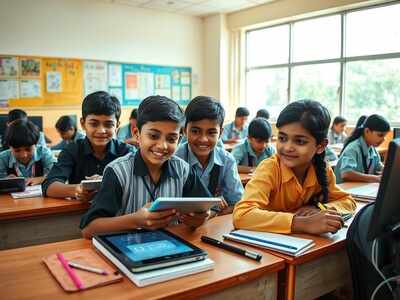
India loves talking about its digital leaps—the UPI revolution, Aadhaar, AI startups. But let’s pause and ask a simpler question: if tomorrow every Indian child were asked to take a class online, how many could actually log in? The uncomfortable answer lies buried in the Unified District Information System for Education Plus (UDISE+) 2024–25 report.
Yes, our schools are better lit, our dropout rates are shrinking, and teachers now cross the one-crore mark. But when it comes to the digital spine of education, we are still running barefoot in a marathon where the rest of the world is on roller skates.
Computer access in Indian schools: A snapshot
The good news first. UDISE+ 2022–23 recorded only 47.7% of schools with computer facilities. That climbed to 57.2% in 2023–24, and now, in 2024–25, 64.7% of schools have computers.
Not bad, one might say. But flip the statistic: more than 35% of schools—over a third—still don’t have a single computer. Imagine a child in 2025 who has never even switched on a computer while her urban peer is coding in Python by middle school.
This is not just a gap; it is a chasm.And what does this mean for India’s much-hyped demographic dividend? That dividend cannot be cashed with chalk and duster. The world is sprinting towards AI-driven learning, while a large slice of Indian students are left tapping blackboards, not keyboards.
Internet access in schools: The Indian scenario
Now to the lifeblood of digital education—the internet. In 2022–23, only 49.7% of schools had internet connectivity. The needle moved slowly to 53.9% in 2023–24, and in 2024–25 it rose to 63.5%. On paper, this looks like healthy growth. But what the data doesn’t cushion is the blunt reality: 36.5% of schools are still offline.Offline in 2025 means cut off—from online libraries, from e-learning platforms, from the possibility of blended education that NEP 2020 waxes eloquent about.
For these students, the “digital classroom” is a phrase in government documents, not a lived experience.
The paradox of infrastructure readiness
Here’s the irony that should sting: UDISE+ 2024–25 also shows 93.6% of schools now have electricity. Power flows, but the internet does not. This paradox of “wires without Wi-Fi” reveals a planning blind spot. We have built the stage, but forgotten to bring in the microphone.It is the equivalent of laying out an Olympic stadium and then forgetting to supply the athletes with running shoes.
The structure is there, but the purpose is defeated.
Why digital gaps matter more than ever
The Education Policy (NEP) 2020 imagines technology as the great leveller—from online teacher training to digital repositories of learning material. But the UDISE+ 2024–25 data bluntly remind us that less than two-thirds of schools are digitally enabled. That means NEP’s “digital vision” is like trying to stream high-definition video on a 2G network: ambitious, inspiring, but frustratingly unworkable.The pandemic already proved how unforgiving this gap is. While students in connected schools switched to Zoom and Teams, their peers in unconnected villages were left squinting at blurry WhatsApp PDFs—or worse, nothing at all. If education is supposed to be the great equaliser, the digital gap is now the great unequaliser.

 1 month ago
1 month ago











